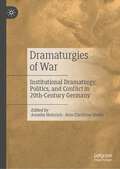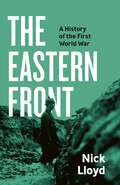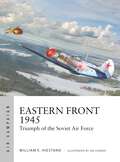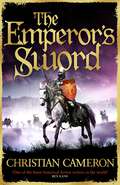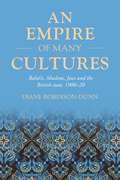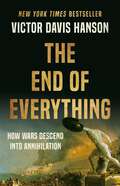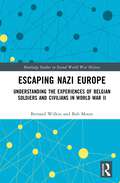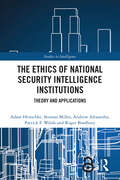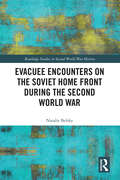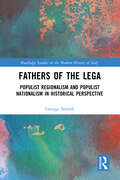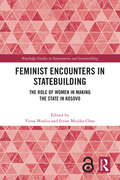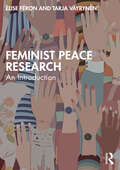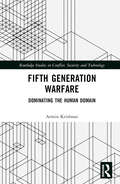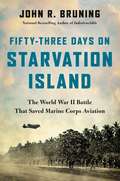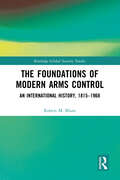- Table View
- List View
Dramaturgies of War: Institutional Dramaturgy, Politics, and Conflict in 20th-Century Germany
by Anselm Heinrich Ann-Christine SimkeThis book examines the institutional contexts of dramaturgical practices in the changing political landscape of 20th century Germany. Through wide-ranging case studies, it discusses the way in which operationalised modes of action, legal frameworks and an established profession have shaped dramaturgical practice and thus links to current debates around the “institutional turn” in theatre and performance studies. German theatre represents a rich and well-chosen field as it is here where the role of the dramaturg was first created and where dramaturgy played a significantly politicised role in the changing political systems of the 20th century. The volume represents an important addition to a growing field of work on dramaturgy by contributing to a historical contextualisation of current practice. In doing so, it understands dramaturgy not only as a process which occurs in rehearsal rooms and writers’ studies, but one that has far wider institutional and political implications.
The Eastern Front: A History of the First World War
by Nick Lloyd'The First World War from a refreshingly unfamiliar angle . . . masterly' Dominic Sandbrook, Sunday Times 'Compelling . . . The Eastern Front is essential reading' Margaret Macmillan, Financial TimesThe definitive history of the Eastern Front in the First World War, from the acclaimed military historian and author of Passchendaele and The Western Front***********In the second volume of his landmark First World War trilogy, Professor Nick Lloyd tells the story for the first time of what Winston Churchill once called the 'unknown war': the vast conflict in Eastern Europe and the Balkans that brought about the collapse of three empires.Much has been written about the fighting in France and Belgium, yet the Eastern Front was no less bloody. Between 1914 and 1917, huge numbers of people - perhaps as many as 16 million soldiers and two million civilians - were killed, wounded or maimed in enormous battles that sometimes ranged across a front of 100 km in length.Through intimate eyewitness reports, diary entries and memoirs - many of which have never been translated into English before - Lloyd reconstructs the full story of a war that began in the Balkans as a local struggle between Austria-Hungary and Serbia, and which sucked in Russia, Germany and Italy, right through to the final collapse of the Habsburg Empire in 1918.The Eastern Front paints a vivid and authoritative picture of a conflict that shook the world, and that remains central to understanding the tragic, blood-soaked trajectory of the twentieth century, and the current war in Ukraine.
Eastern Front 1945: Triumph of the Soviet Air Force (Air Campaign #42)
by William E. HiestandA detailed, illustrated account of the air campaign that accompanied the Red Army's final push towards Berlin, in which massed Soviet air power defeated the Luftwaffe's high-tech Me 262 jets and Mistel exploding drones. The last months of World War II on the Eastern Front saw a ferocious fight between two very different air forces. Soviet Air Force (VVS) Commander-in-Chief Alexander Novikov assembled 7,500 aircraft in three powerful air armies to support the final assault on Berlin. The Luftwaffe employed some of its most advanced weapons including the Me 262 jet and Mistel remotely-guided bomb aircraft. Using photos, 3D diagrams, maps and battlescene artwork, William E. Hiestand, a military analyst with a longstanding interest in Soviet military history, explains how Germany's use of high-tech weaponry and massed Soviet air assaults was not just the culmination of World War II air combat, but also pointed to how the future rivalry with NATO would play out. The VVS used powerful and flexible air armies to control and employ its huge force of aircraft – organizational and employment concepts that would shape Soviet plans and preparations for combat during the Cold War. For the first time, this volume explains how air power helped win the war on the Eastern Front, and how victory shaped Soviet air power doctrine for the decades to come.
The Emperor's Sword: Pre-order the brand new adventure in the Chivalry series! (Chivalry #6)
by Christian CameronThe penultimate instalment in the Chivalry series from a master of historical fiction.The Chivalry series follows young William Gold, who runs away from London to follow the Black Prince, from the killing fields of France, through life as a routier and criminal, and to redemption with the Knights of Saint John, further disillusion and an eventual career as a professional soldier and knight. Rich in the details of life in the High Middle Ages, the series also deals with modern issues about the role of violence in society, rules of conflict and war, and the price that people pay for using violence.'One of the finest historical fiction writers in the world' BEN KANE'The master of historical fiction' SUNDAY TIMES'A storyteller at the height of his powers' HISTORICAL NOVEL SOCIETY
An empire of many cultures: Bahá’ís, Muslims, Jews and the British state, 1900–20 (Studies in Imperialism #212)
by Diane Robinson-DunnBased upon extensive archival research and bringing to life the words and actions of extraordinary individuals from the early 20th century, this book calls into question contemporary assumptions about the appreciation of diversity as a solely postcolonial phenomenon. It shows how Bahá’í, Muslim, and Jewish leaders prior to and during WWI found value in the existence of many different religions, races, languages, nations, and ethnicities within the British Empire. Recognition of this heterogeneity combined with sympathy for certain liberal traditions allowed those historical actors to engage with that imperial state and culture in ways that would have an impact on future generations and relevance to modern debates.
An empire of many cultures: Bahá’ís, Muslims, Jews and the British state, 1900–20 (Studies in Imperialism #212)
by Diane Robinson-DunnBased upon extensive archival research and bringing to life the words and actions of extraordinary individuals from the early 20th century, this book calls into question contemporary assumptions about the appreciation of diversity as a solely postcolonial phenomenon. It shows how Bahá’í, Muslim, and Jewish leaders prior to and during WWI found value in the existence of many different religions, races, languages, nations, and ethnicities within the British Empire. Recognition of this heterogeneity combined with sympathy for certain liberal traditions allowed those historical actors to engage with that imperial state and culture in ways that would have an impact on future generations and relevance to modern debates.
The End of Everything: How Wars Descend into Annihilation
by Victor Davis HansonIn this &“gripping account of catastrophic defeat&” (Barry Strauss), a New York Times–bestselling historian charts how and why some societies chose to utterly destroy their foes, and warns that similar wars of obliteration are possible in our time &“In The End of Everything, Hanson tells compelling and harrowing stories of how civilizations perished. He helps us consider contemporary affairs in light of that history, think about the unthinkable, and recognize the urgency of trying to prevent our own demise.&” — H. R. McMaster, author of Battlegrounds War can settle disputes, topple tyrants, and bend the trajectory of civilization—sometimes to the breaking point. From Troy to Hiroshima, moments when war has ended in utter annihilation have reverberated through the centuries, signaling the end of political systems, cultures, and epochs. Though much has changed over the millennia, human nature remains the same. Modern societies are not immune from the horror of a war of extinction. In The End of Everything, military historian Victor Davis Hanson narrates a series of sieges and sackings that span the age of antiquity to the conquest of the New World to show how societies descend into barbarism and obliteration. In the stories of Thebes, Carthage, Constantinople, and Tenochtitlan, he depicts war&’s drama, violence, and folly. Highlighting the naivete that plagued the vanquished and the wrath that justified mass slaughter, Hanson delivers a sobering call to contemporary readers to heed the lessons of obliteration lest we blunder into catastrophe once again.
England’s Military Heritage from the Air (Historic England)
by Mark Bowden Allan BrodieEngland’s Military Heritage from the Air presents the story of the country’s rich military heritage using photographs from the Aerofilms Collection. Covering over 6,000 years, it reflects the changing threats faced by England from enemies without, and conflicts within. The book covers everything from hillforts to aircraft carriers and includes the castles, battle sites, ships and aircraft that have witnessed the changing character of warfare. Ending with how victory and sacrifice are commemorated and remembered, England’s Military Heritage from the Air is a tribute to the courage, skill and endurance of the people who have suffered yet prevailed.
Escaping Nazi Europe: Understanding the Experiences of Belgian Soldiers and Civilians in World War II (Routledge Studies in Second World War History)
by Bernard Wilkin Bob MooreThis book chronicles the escapes attempted by Belgian soldiers and civilians from Nazi-occupied Europe during the Second World War. Insofar as is practical, the authors have tried to let the subjects speak for themselves by making extensive use of their testimonies preserved in archives in Belgium and the United Kingdom. The book begins with the stories of soldiers who managed to evade capture in the summer of 1940 and returned home, and the few that decided to continue the fight and joined the Allied forces in the United Kingdom. It also includes the prisoners of war who managed to escape from camps or Arbeitskommando inside the Reich and provides a detailed analysis of their narratives: their motivation for going on the run, their choices on when and how to travel, and the many obstacles they encountered along the way. Most escapees were content to return home, with some then joining resistance organisations, but a small minority were committed to joining the Allies, and further chapters recount their attempts to reach Spain and Switzerland, and the additional problems they encountered in those neutral states. Final chapters reflect on the penalties inflicted on prisoners of war who were recaptured and on the escapees’ struggle for recognition in the post-war world.
Escaping Nazi Europe: Understanding the Experiences of Belgian Soldiers and Civilians in World War II (Routledge Studies in Second World War History)
by Bernard Wilkin Bob MooreThis book chronicles the escapes attempted by Belgian soldiers and civilians from Nazi-occupied Europe during the Second World War. Insofar as is practical, the authors have tried to let the subjects speak for themselves by making extensive use of their testimonies preserved in archives in Belgium and the United Kingdom. The book begins with the stories of soldiers who managed to evade capture in the summer of 1940 and returned home, and the few that decided to continue the fight and joined the Allied forces in the United Kingdom. It also includes the prisoners of war who managed to escape from camps or Arbeitskommando inside the Reich and provides a detailed analysis of their narratives: their motivation for going on the run, their choices on when and how to travel, and the many obstacles they encountered along the way. Most escapees were content to return home, with some then joining resistance organisations, but a small minority were committed to joining the Allies, and further chapters recount their attempts to reach Spain and Switzerland, and the additional problems they encountered in those neutral states. Final chapters reflect on the penalties inflicted on prisoners of war who were recaptured and on the escapees’ struggle for recognition in the post-war world.
The Ethics of National Security Intelligence Institutions: Theory and Applications (Studies in Intelligence)
by Adam Henschke Seumas Miller Andrew Alexandra Patrick F. Walsh Roger BradburyThis book explores the ethics of national security intelligence institutions operating in contemporary liberal democracies.Intelligence collection by agencies such as the CIA, MI6, and Mossad involves practices that are apparently inconsistent with the principles of ordinary morality – practices such as lying, spying, manipulation, and covert action. However, in the defence of national security, such practices may not only be morally permissible, but may also under some circumstances be morally obligatory. One approach to the ethics of national security intelligence activity has been to draw from the just war tradition (so-called ‘just intelligence theory’). This book identifies significant limitations of this approach and offers a new, institutionally based, teleological normative framework. In doing so, it revises some familiar principles designed for application to kinetic wars, such as necessity and proportionality, and invokes some additional ones, such as reciprocity and trust. It goes on to explore the applications of this framework and a revised set of principles for national security intelligence institutions and practices in contemporary and emerging political and technological settings.This book will be of much interest to students of intelligence studies, ethics, security studies and International Relations.
The Ethics of National Security Intelligence Institutions: Theory and Applications (Studies in Intelligence)
by Adam Henschke Seumas Miller Andrew Alexandra Patrick F. Walsh Roger BradburyThis book explores the ethics of national security intelligence institutions operating in contemporary liberal democracies.Intelligence collection by agencies such as the CIA, MI6, and Mossad involves practices that are apparently inconsistent with the principles of ordinary morality – practices such as lying, spying, manipulation, and covert action. However, in the defence of national security, such practices may not only be morally permissible, but may also under some circumstances be morally obligatory. One approach to the ethics of national security intelligence activity has been to draw from the just war tradition (so-called ‘just intelligence theory’). This book identifies significant limitations of this approach and offers a new, institutionally based, teleological normative framework. In doing so, it revises some familiar principles designed for application to kinetic wars, such as necessity and proportionality, and invokes some additional ones, such as reciprocity and trust. It goes on to explore the applications of this framework and a revised set of principles for national security intelligence institutions and practices in contemporary and emerging political and technological settings.This book will be of much interest to students of intelligence studies, ethics, security studies and International Relations.
Evacuee Encounters on the Soviet Home Front During the Second World War (Routledge Studies in Second World War History)
by Natalie BelskyThis study is the first to examine the experiences of the millions of Soviet civilians evacuated to the interior of the country during the Second World War in the context of their encounters and relations with local communities and populations across Soviet Central Asia, Kazakhstan, Siberia, and the Urals. The book considers the impact of this episode of massive population displacement across Eurasia on individuals, communities, and society more broadly. It explores how the challenges associated with wartime displacement gave rise to tensions between evacuees and local residents. These frictions, in turn, forced individuals to interrogate the meaning, terms, and limitations of citizenship and belonging in the Soviet Union. Evacuation thus played a critical role in the changing relationship between citizens and the Soviet state in the war and postwar periods. Furthermore, this study pays particular attention to the plight of Soviet Jewish evacuees, who constitute the largest contingent of Holocaust survivors in Europe, and the rise of anti-Semitism on the Soviet home front during the war. This volume will be of interest to students and scholars of the Second World War, migration and displacement, the Holocaust, Soviet Jewish history, and the Soviet experience more broadly.
Evacuee Encounters on the Soviet Home Front During the Second World War (Routledge Studies in Second World War History)
by Natalie BelskyThis study is the first to examine the experiences of the millions of Soviet civilians evacuated to the interior of the country during the Second World War in the context of their encounters and relations with local communities and populations across Soviet Central Asia, Kazakhstan, Siberia, and the Urals. The book considers the impact of this episode of massive population displacement across Eurasia on individuals, communities, and society more broadly. It explores how the challenges associated with wartime displacement gave rise to tensions between evacuees and local residents. These frictions, in turn, forced individuals to interrogate the meaning, terms, and limitations of citizenship and belonging in the Soviet Union. Evacuation thus played a critical role in the changing relationship between citizens and the Soviet state in the war and postwar periods. Furthermore, this study pays particular attention to the plight of Soviet Jewish evacuees, who constitute the largest contingent of Holocaust survivors in Europe, and the rise of anti-Semitism on the Soviet home front during the war. This volume will be of interest to students and scholars of the Second World War, migration and displacement, the Holocaust, Soviet Jewish history, and the Soviet experience more broadly.
Fathers of the Lega: Populist Regionalism and Populist Nationalism in Historical Perspective (Routledge Studies in the Modern History of Italy)
by George NewthThis book investigates the historical roots of the Italian Republic’s oldest surviving political party, the populist far right Lega (Nord), tracing its origins to post-war Italy. The author examines two main case studies: the Movements for Regional Autonomy (MRAs), the Piedmontese Movement for Regional Autonomy (the MARP) and the Bergamascan Movement for Autonomy (the MAB), both of which formed a first wave of post-war populist regionalism from 1955 until 1960. The regionalist leagues which later emerged in both Piedmont and Lombardy in the 1980s – and which would later form part of the Lega Nord – represented in many ways a revival of the MRAs’ populist regionalist discourse and ideology and, therefore, a second wave of post-war populist regionalism. Despite this, neither the MRAs nor the twenty year gap between these waves of activism have received the attention they deserve. Drawing on a series of archival and secondary sources this book takes an innovative approach which blends concepts and theories from historical sociology and political science. It also provides a nuanced examination of the continuities and discontinuities between the MRAs and the Lega from the 1950s until time of publication. This contributes to debates not only in contemporary Italian history, but also populism and the far right. While rooted in historical approaches, the book’s interdisciplinarity makes it suitable for students and researchers across a variety of subject areas including European history, modern history, and political history.
Fathers of the Lega: Populist Regionalism and Populist Nationalism in Historical Perspective (Routledge Studies in the Modern History of Italy)
by George NewthThis book investigates the historical roots of the Italian Republic’s oldest surviving political party, the populist far right Lega (Nord), tracing its origins to post-war Italy. The author examines two main case studies: the Movements for Regional Autonomy (MRAs), the Piedmontese Movement for Regional Autonomy (the MARP) and the Bergamascan Movement for Autonomy (the MAB), both of which formed a first wave of post-war populist regionalism from 1955 until 1960. The regionalist leagues which later emerged in both Piedmont and Lombardy in the 1980s – and which would later form part of the Lega Nord – represented in many ways a revival of the MRAs’ populist regionalist discourse and ideology and, therefore, a second wave of post-war populist regionalism. Despite this, neither the MRAs nor the twenty year gap between these waves of activism have received the attention they deserve. Drawing on a series of archival and secondary sources this book takes an innovative approach which blends concepts and theories from historical sociology and political science. It also provides a nuanced examination of the continuities and discontinuities between the MRAs and the Lega from the 1950s until time of publication. This contributes to debates not only in contemporary Italian history, but also populism and the far right. While rooted in historical approaches, the book’s interdisciplinarity makes it suitable for students and researchers across a variety of subject areas including European history, modern history, and political history.
Feminist Encounters in Statebuilding: The Role of Women in Making the State in Kosovo (Routledge Studies in Intervention and Statebuilding)
by Vjosa Musliu Itziar Mujika ChaoThis volume provides one of the first comprehensive feminist readings of international statebuilding, with a specific focus on the case of Kosovo.Rather than simply showing how the state in Kosovo is being built by and through women and feminist encounters, this volume is interested to problematise women and feminist subjectivities vis-à-vis the state and statebuilding. The book challenges three main arguments related to the processes and subjects of statebuilding in Kosovo. First, the academic literature on Kosovo has a tendency to take the international intervention of 1999 as the originary point of statebuilding processes in Kosovo. Second, and relatedly, given Kosovo's unprecedented exposure to Western intervention and statebuilding, the majority of works start from the presumption that liberal interventionism in Kosovo (and elsewhere) is normatively more progressive than the previous system, and that the liberal interventionism and statebuilding are naturally gender progressive and gender-equal. The third argument has to do with the existing legal architecture on gender and women’s rights in contemporary Kosovo. The aim of the volume is to, on the one hand, problematise the evidence against the backdrop of everyday manifestations and/or performances of statebuilding and on the other hand interrogate the co-constitutive gender aspect. In terms of methodology, the volume brings together contributions that rely on traditional and multi-sited ethnography, and narrative research rooted in projects and initiatives in Kosovo. This allows the contributors to unearth new and silenced actors, entry points, subjects and subjectivities in processes of and related to statebuilding in Kosovo; feminist frictions and challenges to statebuilding in Kosovo; as well as encounters of heteronormative statebuilding.This book will be of much interest to students of statebuilding, Balkan politics, feminisms, and international relations, in general.
Feminist Encounters in Statebuilding: The Role of Women in Making the State in Kosovo (Routledge Studies in Intervention and Statebuilding)
This volume provides one of the first comprehensive feminist readings of international statebuilding, with a specific focus on the case of Kosovo.Rather than simply showing how the state in Kosovo is being built by and through women and feminist encounters, this volume is interested to problematise women and feminist subjectivities vis-à-vis the state and statebuilding. The book challenges three main arguments related to the processes and subjects of statebuilding in Kosovo. First, the academic literature on Kosovo has a tendency to take the international intervention of 1999 as the originary point of statebuilding processes in Kosovo. Second, and relatedly, given Kosovo's unprecedented exposure to Western intervention and statebuilding, the majority of works start from the presumption that liberal interventionism in Kosovo (and elsewhere) is normatively more progressive than the previous system, and that the liberal interventionism and statebuilding are naturally gender progressive and gender-equal. The third argument has to do with the existing legal architecture on gender and women’s rights in contemporary Kosovo. The aim of the volume is to, on the one hand, problematise the evidence against the backdrop of everyday manifestations and/or performances of statebuilding and on the other hand interrogate the co-constitutive gender aspect. In terms of methodology, the volume brings together contributions that rely on traditional and multi-sited ethnography, and narrative research rooted in projects and initiatives in Kosovo. This allows the contributors to unearth new and silenced actors, entry points, subjects and subjectivities in processes of and related to statebuilding in Kosovo; feminist frictions and challenges to statebuilding in Kosovo; as well as encounters of heteronormative statebuilding.This book will be of much interest to students of statebuilding, Balkan politics, feminisms, and international relations, in general.
Feminist Peace Research: An Introduction
by Élise Féron Tarja VäyrynenThis textbook provides a comprehensive overview of the field of gender, feminism and peace.It is based on the argument that feminist thinking is necessary to understand and analyse the core issues in peace and conflict studies and is fundamental to thinking about solutions to global problems and to promoting peaceful conflict transformation. The book centres alternative and critical approaches missing in mainstream peace research and brings forward feminist perspectives on traditional peace research topics such as militarism, peacekeeping, arms trade and the articulation of different forms of violence. It also advances critical and alternative issues and topics that traditional peace research has sidelined, including, for example, artificial intelligence, technologies and peace; trauma and memory; human–non-human species relations; art; popular culture; post-colonial and decolonial feminist perspectives; and the queering of war and peace. In sum, this textbook contributes to the visibility of these feminist critical approaches to peace research and makes them accessible to scholars and students interested in the subject.This book will be of much interest to students of peace studies, feminist theory, gender studies and International Relations.
Feminist Peace Research: An Introduction
by Élise Féron Tarja VäyrynenThis textbook provides a comprehensive overview of the field of gender, feminism and peace.It is based on the argument that feminist thinking is necessary to understand and analyse the core issues in peace and conflict studies and is fundamental to thinking about solutions to global problems and to promoting peaceful conflict transformation. The book centres alternative and critical approaches missing in mainstream peace research and brings forward feminist perspectives on traditional peace research topics such as militarism, peacekeeping, arms trade and the articulation of different forms of violence. It also advances critical and alternative issues and topics that traditional peace research has sidelined, including, for example, artificial intelligence, technologies and peace; trauma and memory; human–non-human species relations; art; popular culture; post-colonial and decolonial feminist perspectives; and the queering of war and peace. In sum, this textbook contributes to the visibility of these feminist critical approaches to peace research and makes them accessible to scholars and students interested in the subject.This book will be of much interest to students of peace studies, feminist theory, gender studies and International Relations.
Fifth Generation Warfare: Dominating the Human Domain (Routledge Studies in Conflict, Security and Technology)
by Armin KrishnanThis book outlines the concept of Fifth Generation Warfare (5GW) and demonstrates its relevance for understanding contemporary conflicts.Non-kinetic modes of attack and war waged by groups or non-state actors at the societal level has been termed 5GW. This book discusses the theory of generational warfare and explores the key ideas of 5GW, such as secrecy, the manipulation of proxies, the manipulation of identity and culture (including disinformation and big data), and the use of psychological warfare. These techniques are used to achieve strategic objectives, such as inducing desired behaviour and controlling human terrain, without resorting to overt war or overt violence. The text expands the debate on 5GW by exploring emerging technologies and how they could be used for maliciously shaping human society and even for maliciously changing the genetic makeup of a population for the purpose of unprecedented social control. The work closes with comments on the possibility of a Sixth Generation of Warfare, which targets technical systems to possibly collapse a society through strategic sabotage. Overall, the book demonstrates the relevance of 5GW for understanding contemporary conflicts, from the Arab Spring to the war in Ukraine, in terms of the need for dominating the human domain.This book will be of interest to students of security and technology, defence studies and International Relations.
Fifth Generation Warfare: Dominating the Human Domain (Routledge Studies in Conflict, Security and Technology)
by Armin KrishnanThis book outlines the concept of Fifth Generation Warfare (5GW) and demonstrates its relevance for understanding contemporary conflicts.Non-kinetic modes of attack and war waged by groups or non-state actors at the societal level has been termed 5GW. This book discusses the theory of generational warfare and explores the key ideas of 5GW, such as secrecy, the manipulation of proxies, the manipulation of identity and culture (including disinformation and big data), and the use of psychological warfare. These techniques are used to achieve strategic objectives, such as inducing desired behaviour and controlling human terrain, without resorting to overt war or overt violence. The text expands the debate on 5GW by exploring emerging technologies and how they could be used for maliciously shaping human society and even for maliciously changing the genetic makeup of a population for the purpose of unprecedented social control. The work closes with comments on the possibility of a Sixth Generation of Warfare, which targets technical systems to possibly collapse a society through strategic sabotage. Overall, the book demonstrates the relevance of 5GW for understanding contemporary conflicts, from the Arab Spring to the war in Ukraine, in terms of the need for dominating the human domain.This book will be of interest to students of security and technology, defence studies and International Relations.
Fifty-Three Days on Starvation Island: The World War II Battle That Saved Marine Corps Aviation
by John R BruningThe pivotal true story of the first fifty-three days of the standoff between Imperial Japanese and a handful of Marine aviators defending the Americans dug in at Guadalcanal, from the New York Times bestselling author of Indestructible and Race of Aces. On August 20, 1942, twelve Marine dive-bombers and nineteen Marine fighters landed at Guadalcanal. Their mission: defeat the Japanese navy and prevent it from sending more men and supplies to "Starvation Island," as Guadalcanal was nicknamed. The Japanese were turning the remote, jungle-covered mountain in the south Solomon Islands into an air base from which they could attack the supply lines between the U.S. and Australia. The night after the Marines landed and captured the partially completed airfield, the Imperial Navy launched a surprise night attack on the Allied fleet offshore, resulting in the worst defeat the U.S. Navy suffered in the 20th century, which prompted the abandonment of the Marines on Guadalcanal. The Marines dug in, and waited for help, as those thirty-one pilots and twelve gunners flew against the Japanese, shooting down eighty-three planes in less than two months, while the dive bombers, carried out over thirty attacks on the Japanese fleet. Fifty-Three Days on Starvation Island follows Major John L. Smith, a magnetic leader who became America&’s top fighter ace for the time; Captain Marion Carl, the Marine Corps&’ first ace, and one of the few survivors of his squadron at the Battle of Midway. He would be shot down and forced to make his way back to base through twenty-five miles of Japanese-held jungle. And Major Richard Mangrum, the lawyer-turned-dive-bomber commander whose inexperienced men wrought havoc on the Japanese Navy. New York Times bestselling author John R. Bruning depicts the desperate effort to stop the Japanese long enough for America to muster reinforcements and turn the tide at Guadalcanal. Not just the story of an incredible stand on a distant jungle island, Fifty-Three Days on Starvation Island also explores the consequences of victory to the men who secured it at a time when America had been at war for less than a year and its public had yet to fully understand what that meant. The home front they returned to after their jungle ordeal was a surreal montage of football games, nightclubs, fine dining with America&’s elites, and inside looks at dysfunctional defense industries more interested in fleecing the government than properly equipping the military. Bruning tells the story of how one battle reshaped the Marine Corps and propelled its veterans into the highest positions of power just in time to lead the service into a new war in Southeast Asia.
The Foundations of Modern Arms Control: An International History, 1815-1968 (Routledge Global Security Studies)
by Robert M. BlumThis book is an international history of the foundation of modern arms control, highlighting the fact that the instrument is varied, resilient, successful, and enduring.The narrative begins after the Napoleonic wars when newly arisen peace movements focused on arbitration as a path to “ending the war system.” It moves on to the international community’s embrace of “total and complete disarmament” and then to its acceptance of more limited measures by 1968, including the agreements that remain in force today. The book connects the past to the present of multiple negotiations, successful and failed, and underlines how the peace movement increasingly influenced the national policy of the major Western powers, especially the United States. It also highlights the increasing diversification of arms control players, including women and people of color as well as the countries they represented. Based on original research in multinational records and the latest scholarship, the book illustrates the reasons multilateral arms control remains a key instrument of international relations. The chapters are organized both chronologically and thematically, with the result that they cover different amounts of time in order to encompass a given issue and to capture the development of particular threads. The main narrative evolves into a decadeslong quest for a global treaty on “general and complete disarmament,” which otherwise paces the book and shapes its chapters.This book will be of much interest to students of arms control, global governance, peace studies, and International Relations.
The Foundations of Modern Arms Control: An International History, 1815-1968 (Routledge Global Security Studies)
by Robert M. BlumThis book is an international history of the foundation of modern arms control, highlighting the fact that the instrument is varied, resilient, successful, and enduring.The narrative begins after the Napoleonic wars when newly arisen peace movements focused on arbitration as a path to “ending the war system.” It moves on to the international community’s embrace of “total and complete disarmament” and then to its acceptance of more limited measures by 1968, including the agreements that remain in force today. The book connects the past to the present of multiple negotiations, successful and failed, and underlines how the peace movement increasingly influenced the national policy of the major Western powers, especially the United States. It also highlights the increasing diversification of arms control players, including women and people of color as well as the countries they represented. Based on original research in multinational records and the latest scholarship, the book illustrates the reasons multilateral arms control remains a key instrument of international relations. The chapters are organized both chronologically and thematically, with the result that they cover different amounts of time in order to encompass a given issue and to capture the development of particular threads. The main narrative evolves into a decadeslong quest for a global treaty on “general and complete disarmament,” which otherwise paces the book and shapes its chapters.This book will be of much interest to students of arms control, global governance, peace studies, and International Relations.
